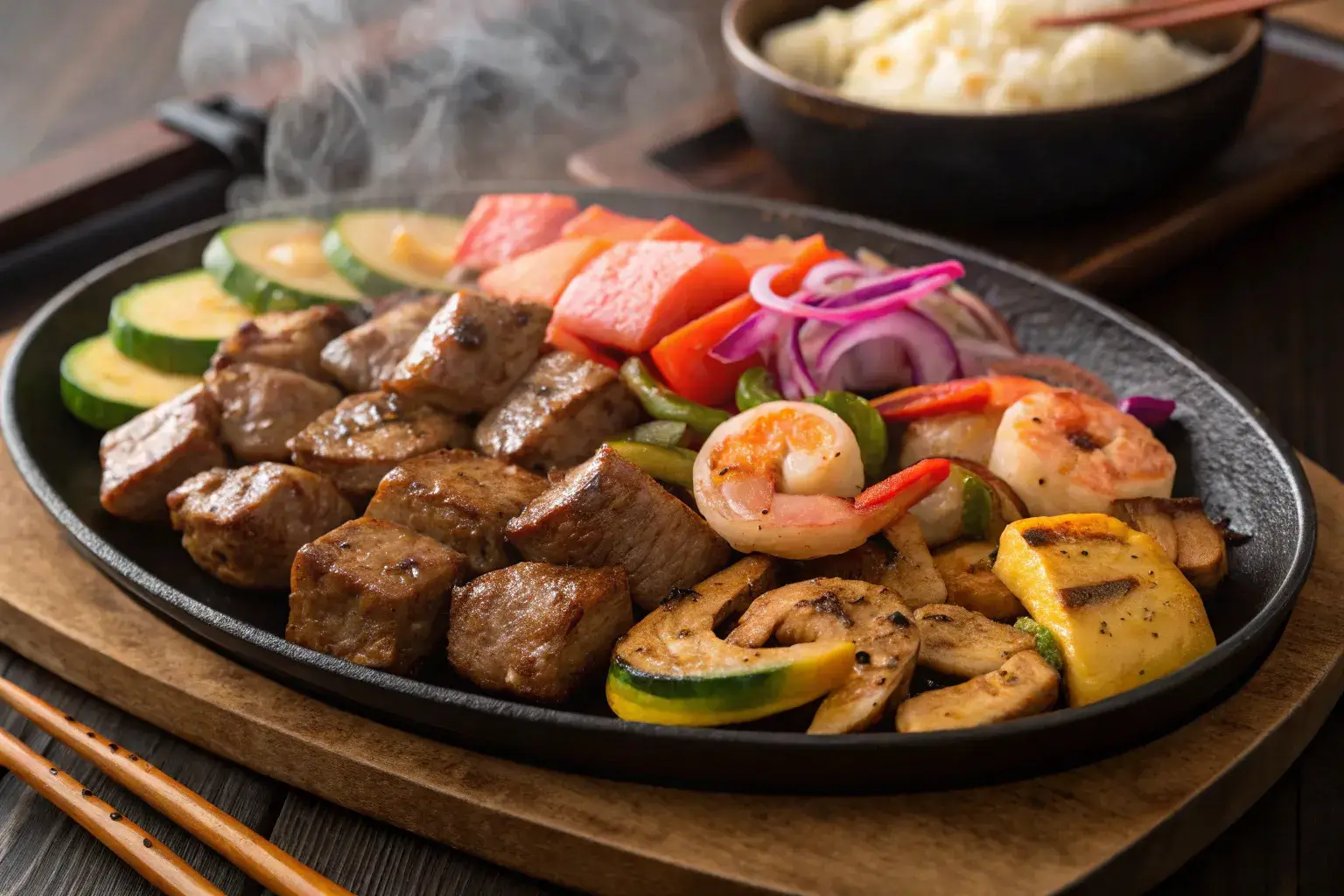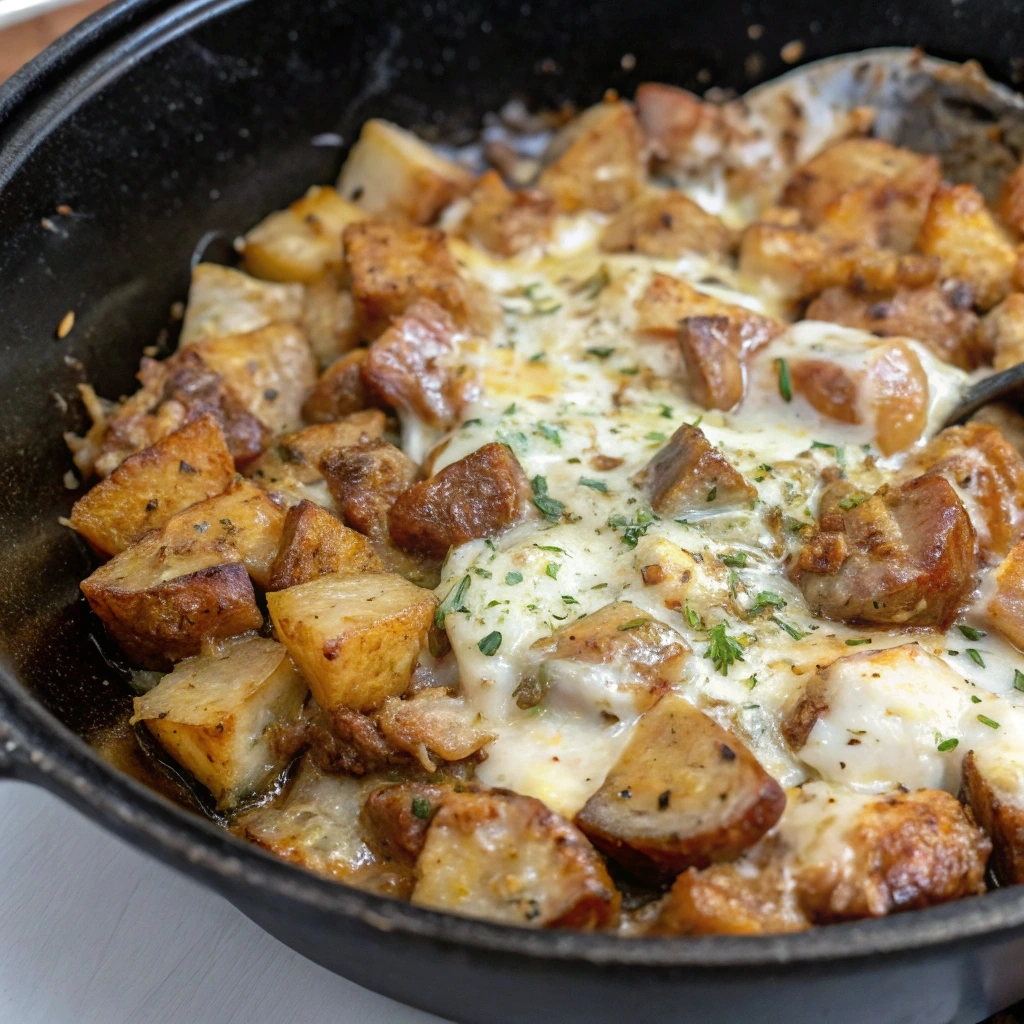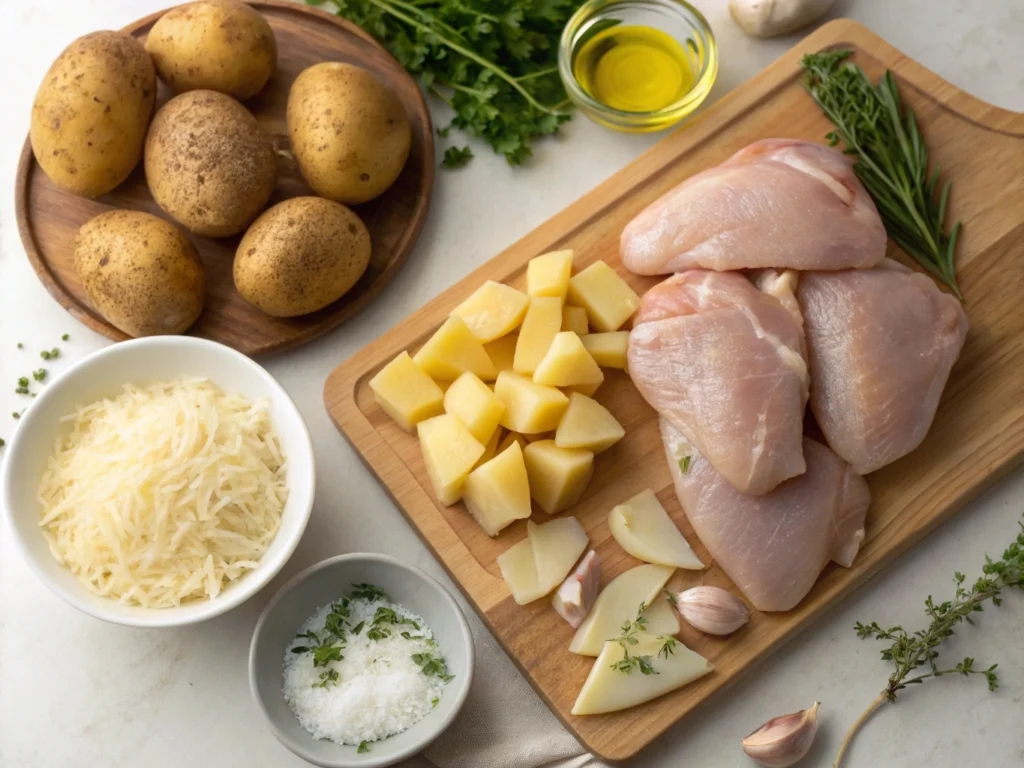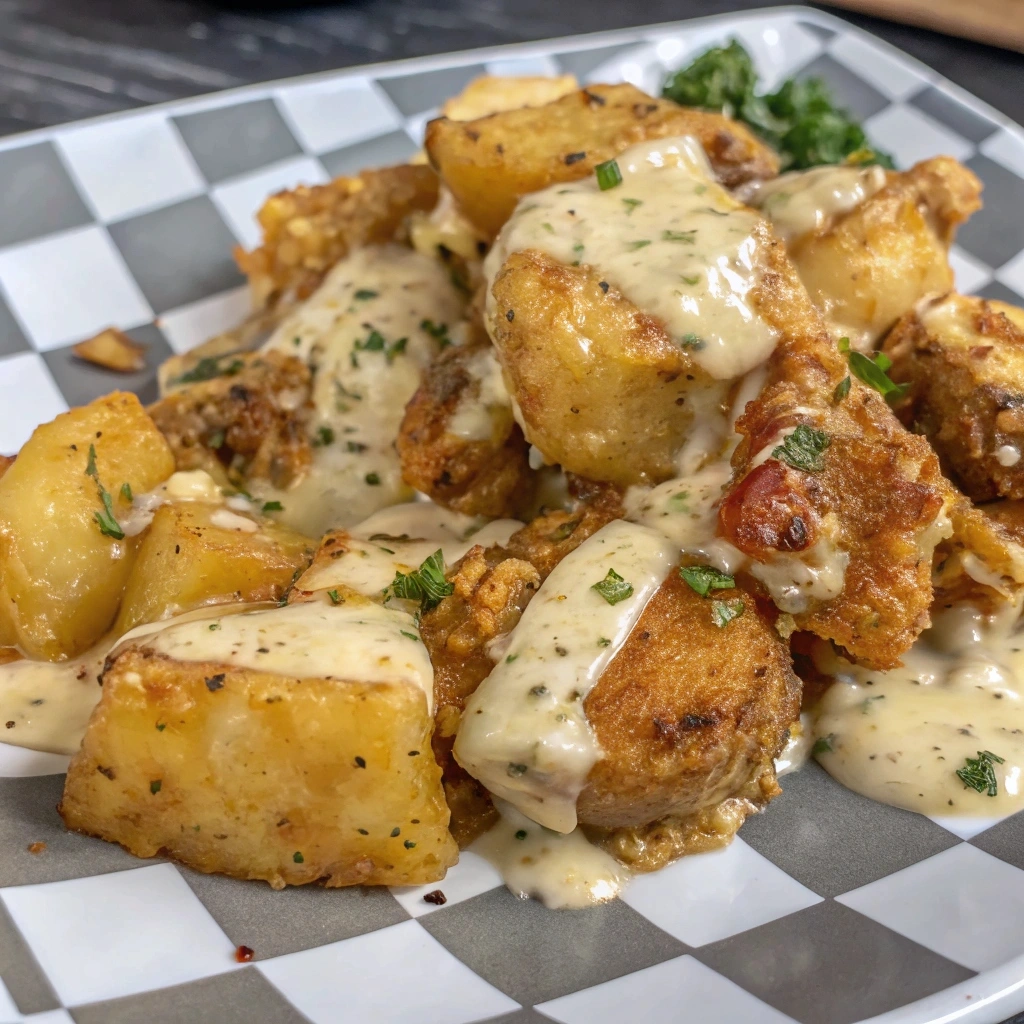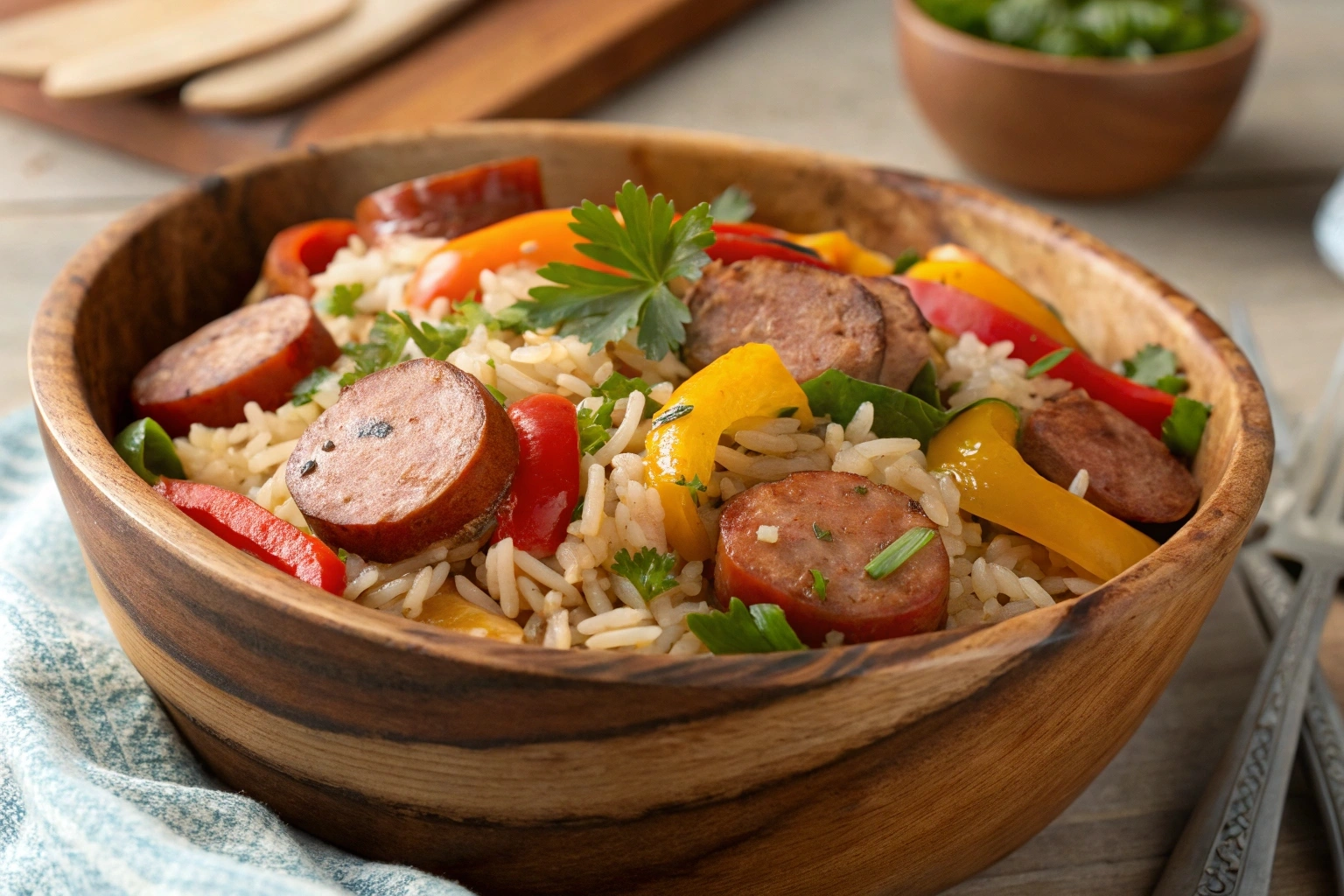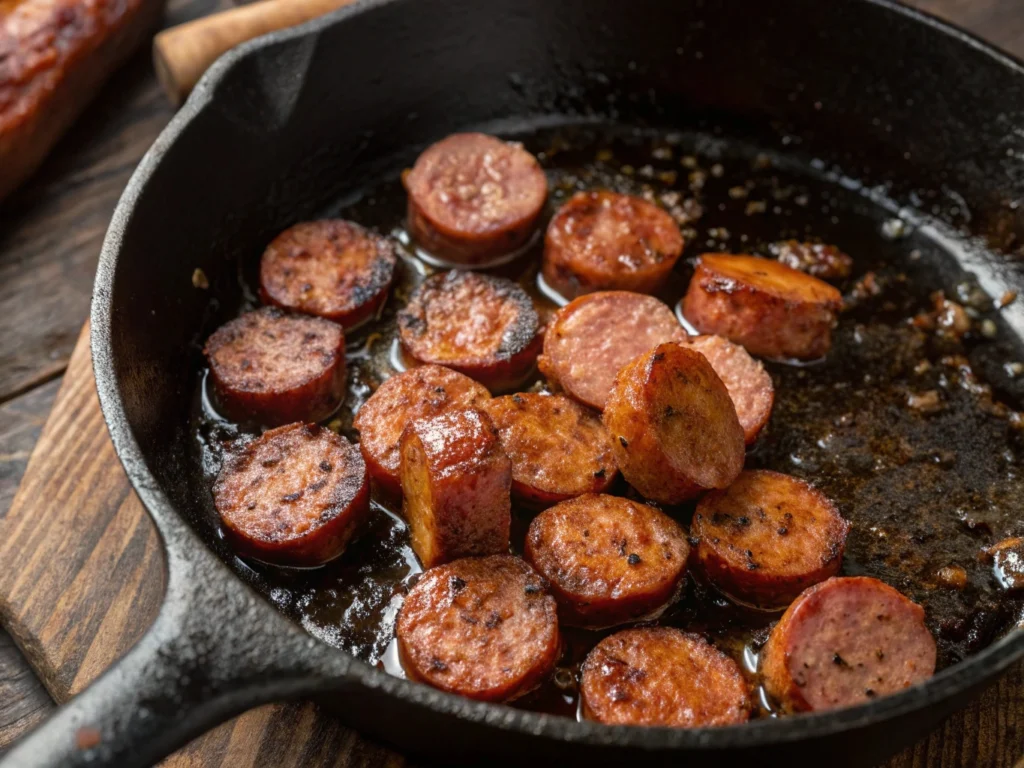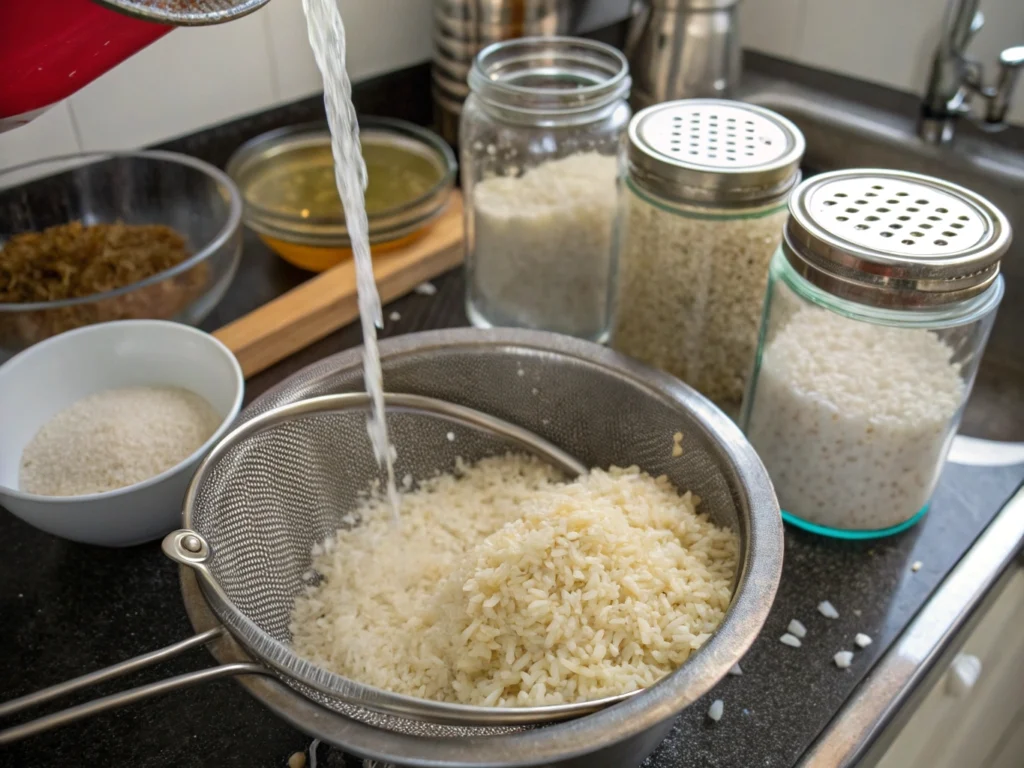Craving that sizzling, flavorful experience of a Japanese steakhouse? With this hibachi steak and shrimp recipe, you can bring all the excitement and taste of hibachi right into your own kitchen. Imagine tender, juicy steak, perfectly seared shrimp, and crisp vegetables all tossed in a buttery garlic sauce it’s a feast for the senses! The best part? You don’t need a fancy grill or hours of prep time to pull it off. In just 20 minutes, you’ll have a restaurant-quality meal that’s as fun to make as it is to eat. So, grab your skillet, and let’s dive into the savory world of homemade hibachi you’re going to love it!
Table of Contents
What Is Hibachi Cooking?
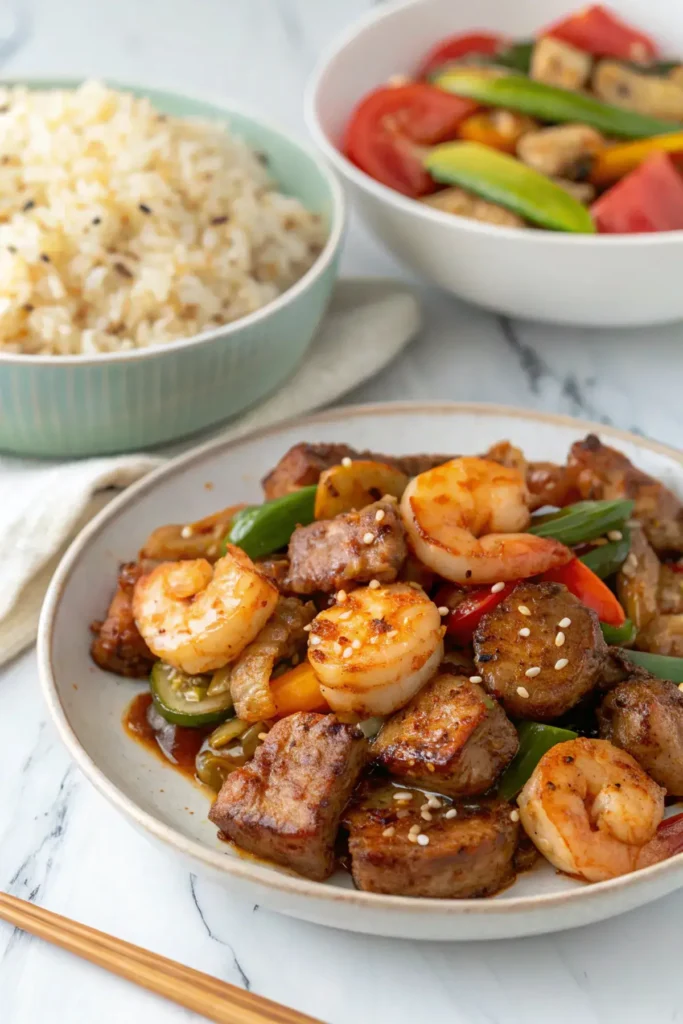
The Origin of Hibachi Cooking
Hibachi cooking has its roots in Japan, where it originally referred to a traditional heating device. However, over time, the term evolved to represent a style of cooking that involves grilling food on a flat, open surface. This method gained popularity for its simplicity and the way it enhances the natural flavors of fresh ingredients. While authentic hibachi grilling uses charcoal, modern hibachi recipes like hibachi steak and shrimp are often prepared on flat-top grills or skillets, making them accessible to home cooks. The beauty of hibachi lies in its ability to bring bold, savory flavors to life with minimal fuss perfect for busy households or special occasions.
Why Hibachi Steak and Shrimp?
There’s something uniquely satisfying about the pairing of hibachi steak and shrimp. The tender, juicy steak complements the sweet, succulent shrimp, creating a balance of textures and flavors that’s hard to resist. In addition to being a classic combo, it’s also versatile. Whether you’re craving a quick weeknight dinner or entertaining guests, this dish delivers restaurant-quality results with minimal effort. Plus, the garlic butter sauce that coats every bite is a game-changer, adding richness without overwhelming the dish. For those who enjoy vibrant, flavorful meals, hibachi is a must-try.
Must-Have Tools for Hibachi at Home
To recreate the magic of hibachi steak and shrimp in your own kitchen, you’ll need the right tools. A flat-top grill or cast-iron skillet works best because they can handle the high heat necessary for searing and caramelizing the food. If you don’t own a flat-top grill, don’t worry—a heavy-bottomed skillet is a fantastic alternative. Other essentials include a sharp knife for cutting steak and vegetables, metal spatulas for flipping and tossing ingredients, and a pair of tongs for handling shrimp. For those looking to elevate their setup, a tabletop electric griddle is a great investment that mimics the hibachi restaurant experience.
Tips for Creating Authentic Hibachi Flavors
Achieving the authentic taste of hibachi steak and shrimp comes down to a few key ingredients and techniques. Soy sauce, sesame oil, and garlic butter are the backbone of most hibachi dishes, offering a rich, umami-packed flavor profile. Don’t forget to add freshly grated ginger or a splash of lemon juice to brighten the dish. Cooking at high heat is another essential step it helps seal in the juices of the steak while giving the shrimp a perfectly caramelized exterior.
Ingredients for Hibachi Steak and Shrimp
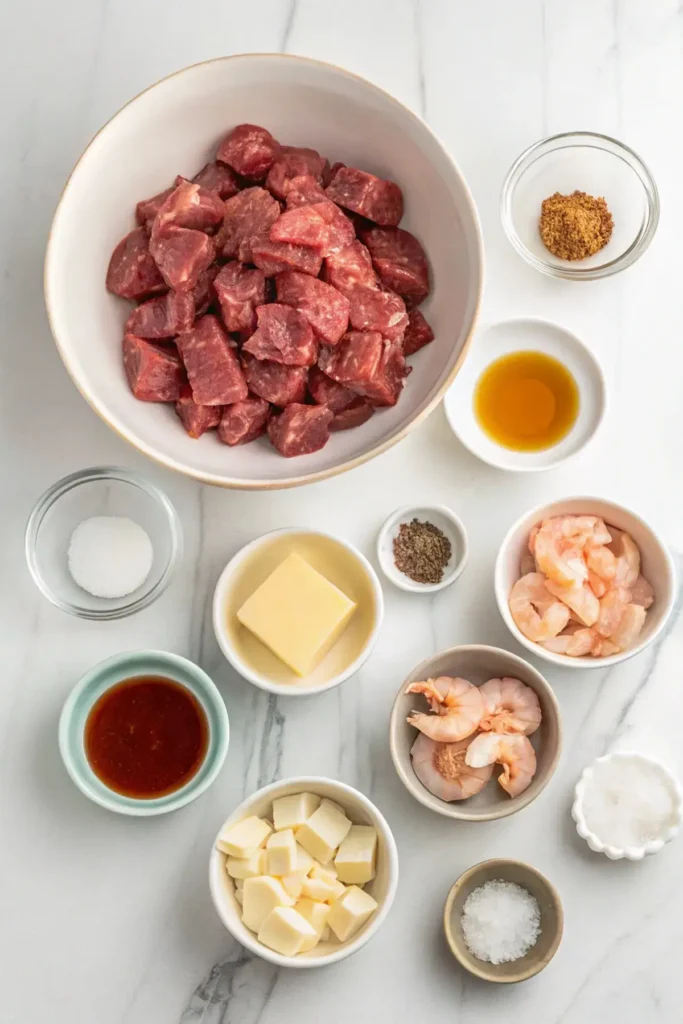
Choosing the Best Steak and Shrimp
Selecting the right ingredients is key to creating flavorful hibachi steak and shrimp. For the steak, opt for tender cuts like ribeye, New York strip, or filet mignon, as these deliver the perfect balance of juiciness and flavor. When it comes to shrimp, large or jumbo varieties work best—look for fresh, deveined shrimp with the shells removed for convenience. If you can’t find fresh shrimp, frozen options are just as good—just thaw them overnight in the refrigerator. By starting with high-quality proteins, you set the stage for a truly restaurant-worthy dish.
Key Seasonings and Sauces
The bold flavors of hibachi steak and shrimp come from its signature seasoning blend. Essential ingredients include soy sauce, garlic butter, sesame oil, and a pinch of ginger. These simple pantry staples create the savory, umami-packed profile hibachi is known for. For an extra layer of flavor, add a splash of lemon juice to brighten the dish. Want to make it even more authentic? Serve with a dollop of homemade Chimichurri Sauce a sweet and tangy dipping sauce that perfectly complements the steak and shrimp.
Vegetable Additions
A classic hibachi meal isn’t complete without colorful, sautéed vegetables. Popular choices include zucchini, onions, mushrooms, and broccoli, which bring both flavor and texture to the dish. Slice your veggies evenly so they cook at the same rate, and toss them in sesame oil and soy sauce before stir-frying. The result? Tender-crisp vegetables that pair beautifully with the savory steak and shrimp. If you’re short on time, pre-chopped vegetable mixes from the store can be a great shortcut.
Balancing the Plate: Rice and Noodles
While hibachi steak and shrimp can shine on its own, pairing it with fried rice or noodles takes the meal to the next level. Hibachi fried rice, cooked with a splash of soy sauce, scrambled eggs, and green onions, is a crowd favorite. If you prefer noodles, use yakisoba or udon, tossing them in garlic butter and soy sauce for a delicious side. These carb-based additions not only complete the dish but also soak up every bit of that irresistible hibachi sauce.
Step-by-Step Hibachi Steak and Shrimp Recipe
Step 1: Prep the Ingredients
Preparation is the foundation of a smooth cooking experience, especially for a quick dish like hibachi steak and shrimp. Start by cutting your steak into bite-sized pieces—this not only ensures even cooking but also makes serving easier. Next, peel and devein the shrimp, leaving the tails on for a restaurant-style presentation. For the vegetables, slice zucchini, onion, and mushrooms into uniform pieces so they cook evenly. Finally, prepare the sauce by mixing soy sauce, garlic butter, and a splash of sesame oil in a small bowl. By organizing everything beforehand, you’ll save time and avoid last-minute scrambling.
Step 2: Make the Garlic Butter Sauce
The secret to the rich, savory flavor of hibachi steak and shrimp lies in its garlic butter sauce. In a small saucepan, melt unsalted butter over low heat, then stir in minced garlic until fragrant. Add soy sauce, sesame oil, and a touch of ginger for extra depth. Stir the mixture until well combined and silky smooth. This sauce not only coats the steak and shrimp beautifully but also doubles as a drizzle for rice or noodles. For a citrusy twist, consider adding a squeeze of fresh lemon juice before serving.
Step 3: Cook the Steak and Shrimp
Cooking hibachi steak and shrimp is all about high heat and quick movements. Heat a flat-top grill or a large skillet until it’s almost smoking. Start with the steak, searing the pieces for about 2–3 minutes per side until browned and cooked to your desired doneness. Remove the steak and set it aside. Next, add the shrimp to the same pan, cooking them for 2–3 minutes per side or until they turn pink and opaque. The high heat ensures a caramelized crust on the steak and a slightly charred exterior on the shrimp, which enhances the flavor.
Step 4: Add the Vegetables and Combine
Once the steak and shrimp are cooked, it’s time to bring everything together. Toss the prepared vegetables into the skillet, stirring constantly to prevent burning. Cook until they’re tender but still crisp—about 4–5 minutes. Add the steak, shrimp, and garlic butter sauce back to the pan, tossing everything together to coat evenly. This step melds the flavors, making every bite of your hibachi steak and shrimp perfectly balanced and delicious. Serve immediately alongside fried rice or noodles for a complete meal.
If you enjoyed learning how to prepare hibachi steak and shrimp, you might also like these recipes:
Tips and Tricks for Perfect Hibachi Steak and Shrimp
Secrets to Getting Restaurant-Quality Results
Recreating the magic of restaurant-style hibachi steak and shrimp at home is easier than you think with a few insider tips. First, always cook over high heat to achieve that signature sear. A flat-top grill or cast-iron skillet works wonders for this because it holds heat evenly. Secondly, don’t overcrowd the pan if the steak and shrimp are too close together, they’ll steam instead of sear, resulting in less flavor. Finally, use fresh ingredients whenever possible. Freshly minced garlic, quality soy sauce, and real butter can make a noticeable difference in the taste and aroma of your dish.
Time-Saving Hacks
Preparing hibachi steak and shrimp can be even quicker with a few clever shortcuts. Pre-chopped vegetables from the store save time without sacrificing quality, and pre-minced garlic can make your prep work a breeze. If you’re in a pinch, consider using frozen shrimp, but make sure to thaw them properly before cooking. Another trick is to double the garlic butter sauce recipe and store the extra in the fridge for future meals it’s perfect for drizzling over rice or vegetables later in the week.
Ingredient Substitutions
Sometimes, you may want to tweak your hibachi steak and shrimp recipe to suit your preferences or dietary needs. For a leaner option, substitute chicken breast or tofu for the steak. If you’re avoiding soy, coconut aminos can be used as a flavorful alternative to soy sauce. Don’t have sesame oil? Try using a mild olive oil instead. These swaps ensure that everyone can enjoy the bold flavors of hibachi while catering to their specific needs.
Serving Suggestions and Pairings
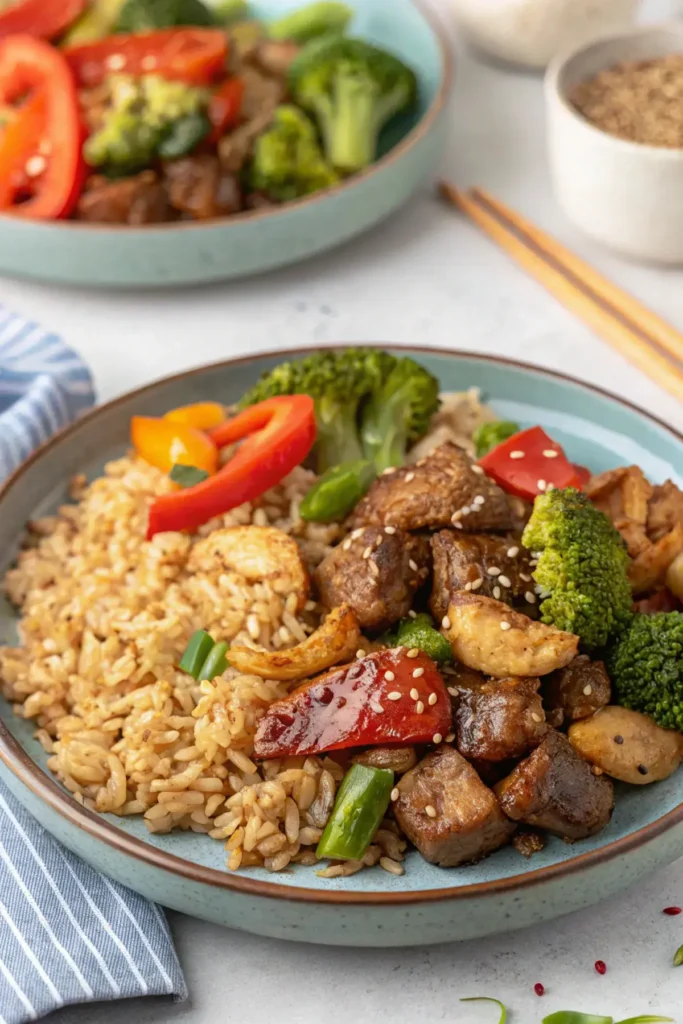
To elevate your hibachi steak and shrimp meal, pair it with classic sides that complement the dish’s rich flavors. Hibachi fried rice, made with scrambled eggs, soy sauce, and green onions, is a traditional choice. Alternatively, garlic butter noodles or a simple mixed greens salad provide a refreshing balance to the savory main course. For drinks, green tea or a light sake pairs beautifully, while a crisp white wine like Sauvignon Blanc adds an elegant touch.
Common Mistakes to Avoid
Overcrowding the Pan
One of the most common pitfalls when making hibachi steak and shrimp is overcrowding the pan. When too many ingredients are crammed into the skillet, the heat distribution is uneven, and instead of searing, the steak and shrimp steam. This results in a less flavorful dish with a soggy texture. To avoid this, cook in batches if necessary, giving each piece enough space to develop a golden, caramelized crust. It may take a bit longer, but the end result is well worth it.
Using the Wrong Cooking Surface
The type of cookware you use plays a huge role in the success of your hibachi steak and shrimp. Nonstick pans are tempting, but they don’t handle the high heat required for proper searing. Instead, opt for a flat-top grill, cast-iron skillet, or stainless steel pan. These surfaces retain heat better, ensuring your proteins and vegetables cook evenly. If a flat-top grill isn’t available, a griddle is a fantastic alternative for achieving that restaurant-quality sear.
Skipping the Garlic Butter Sauce
While the steak and shrimp are delicious on their own, skipping the garlic butter sauce would be a missed opportunity to elevate the dish. This sauce adds a rich, savory layer of flavor that ties the entire meal together. Be sure to coat the shrimp, steak, and vegetables generously, letting the sauce seep into every bite. For an extra burst of flavor, drizzle the sauce over your side of fried rice or noodles it’s a simple step that makes a big difference.
Overcooking the Shrimp
Shrimp cook incredibly quickly, and leaving them on the heat for too long can turn them rubbery and dry. To avoid this, keep a close eye on the shrimp and cook them for just 2–3 minutes per side, or until they turn pink and opaque. Remember, they’ll continue to cook slightly after being removed from the pan. Perfectly cooked shrimp should be tender, juicy, and bursting with flavor, complementing the seared steak beautifully.
FAQs
What type of steak is used for hibachi?
The best type of steak for hibachi steak and shrimp is a tender, flavorful cut that cooks quickly and evenly. Ribeye, New York strip, and filet mignon are popular choices because they have the right balance of fat and tenderness to achieve that juicy, melt-in-your-mouth texture. If you prefer a leaner option, sirloin steak is a great alternative that still delivers excellent flavor. Always cut the steak into bite-sized pieces before cooking to ensure even searing and easy serving.
Is steak and shrimp hibachi healthy?
Yes, hibachi steak and shrimp can be a healthy meal, depending on how it’s prepared. The dish typically includes lean proteins (steak and shrimp), fresh vegetables, and simple seasonings like soy sauce and garlic. To make it even healthier, use minimal butter and opt for low-sodium soy sauce. Pairing the dish with steamed rice or a light salad instead of fried rice can also reduce the calorie count. This makes hibachi a well-rounded option that’s both satisfying and nutritious.
What seasoning do they use at hibachi?
Hibachi dishes like hibachi steak and shrimp are known for their bold, savory flavors, achieved with a handful of simple seasonings. The essentials include soy sauce, sesame oil, garlic, and ginger. Some chefs also add mirin (a sweet rice wine) or a splash of sake for depth. The dish is often finished with a generous dollop of garlic butter, which enhances the flavor while adding a rich, creamy texture. These seasonings combine to create the unmistakable umami profile that makes hibachi so delicious.
What kind of shrimp is used in hibachi?
For hibachi steak and shrimp, large or jumbo shrimp are ideal. These sizes cook evenly, hold up well to high heat, and have a sweet, succulent flavor that complements the steak. Make sure the shrimp are peeled and deveined for convenience, though leaving the tails on can add a professional touch to the presentation. Whether you choose fresh or frozen shrimp, thaw them completely before cooking to ensure they sear properly and absorb the flavors of the sauce.
Conclusion
Recreating the magic of restaurant-style hibachi steak and shrimp at home is a fun and rewarding experience. By choosing tender cuts of steak like ribeye or filet mignon and pairing them with fresh jumbo shrimp, you set the foundation for a flavorful dish. The bold seasonings—soy sauce, sesame oil, garlic, and butter are simple yet essential for achieving the authentic hibachi taste.
So, what are you waiting for? Grab your skillet, gather your ingredients, and bring the sizzling flavors of hibachi steak and shrimp to your table tonight. Let us know how it turns out in the comments below!

